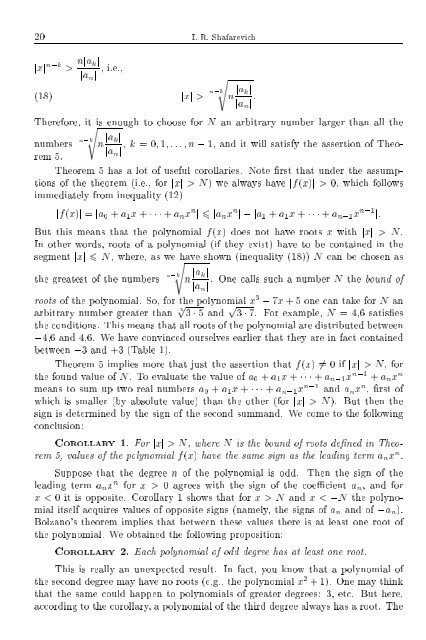SELECTED CHAPTERS FROM ALGEBRA I. R. Shafarevich Preface
SELECTED CHAPTERS FROM ALGEBRA I. R. Shafarevich Preface
SELECTED CHAPTERS FROM ALGEBRA I. R. Shafarevich Preface
Create successful ePaper yourself
Turn your PDF publications into a flip-book with our unique Google optimized e-Paper software.
20 I. R. <strong>Shafarevich</strong>jxj n;k > nja kjja n j , i.e.,(18) jxj > n;k sn ja kjja n j :Therefore, it sis enough to choose for N an arbitrary number larger than all thenumbers n;k n ja kj, k =0 1 ...n; 1, and it will satisfy the assertion of Theorem5.ja n jTheorem 5 has a lot of useful corollaries. Note rst that under the assumptionsof the theorem (i.e., for jxj >N) we always have jf(x)j > 0, which followsimmediately from inequality (12)jf(x)j = ja 0 + a 1 x + + a n x n j 6 ja n x n j;ja 1 + a 1 x + + a n;1x n;1 j:But this means that the polynomial f(x) does not have roots x with jxj > N.In other words, roots of a polynomial (if they exist) have to be contained in thesegment jxj 6 N, where, as weshave shown (inequality (18)) N can be chosen asthe greatest of the numbers n;k n ja kj. One calls such anumber N the bound ofja n jroots of the polynomial. So, for the polynomial x 3 ; 7x + 5 one can take forN anarbitrary number greater than 3p 3 5 and p 3 7. For example, N =46 satisesthe conditions. This means that all roots of the polynomial are distributed between;46 and46. We have convinced ourselves earlier that they are in fact containedbetween ;3 and +3 (Table 1).Theorem 5 implies more that just the assertion that f(x) 6= 0ifjxj >N,forthe found value of N. To evaluate the value of a 0 + a 1 x + + a n;1x n;1 + a n x nmeans to sum up two real numbers a 0 + a 1 x + + a n;1x n;1 and a n x n , rst ofwhich is smaller (by absolute value) than the other (for jxj >N). But then thesign is determined by the sign of the second summand. We come to the followingconclusion:COROLLARY 1. For jxj >N,where N is the bound of roots dened inTheorem5, values of the polynomial f(x) have the same sign as the leading term a n x n .Suppose that the degree n of the polynomial is odd. Then the sign of theleading term a n x n for x > 0 agrees with the sign of the coecient a n , and forxN and x
















